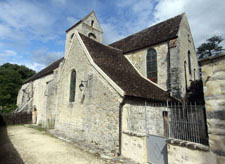Fleury-en-Bière (Seine-et-Marne, France) - Notre-Dame-de-l'Assomption
- Disclaimer
The dating found here is based on the work of John James, and is meant on this site to serve as a starting point. James' dating is derived from a system that uses his interpretation of the development of capitals over time as the basis for chronology, among other factors. His goal is to refine the dating to within years rather than decades. I have not fully embraced James' methodology, and will be developing this page from its current state to one which is admittedly more conservative. The relative expenditure values found in the Timeline are also based on James' work, and I believe these to be reasonably reliable. They are intended only to give a sense of the amount of work involved in each decade.
I have added the idea of the "project" as a way of separating work in buildings. In my mind, a "project" is a discrete section of work in a building that resulted from the one-time acquisition of funding. "Projects" are generally separated by at least a decade where no work was being done. It is my view that it would have been unwise to start a "project" that could not be finished and protected from the elements, and as such a "project" usually involved a wing or multiple wings of a building, from floor to roof. Rural churches, which could only secure small amounts of funding at irregular intervals, often were the result of many small projects, while the great churches, which benefitted from relatively consistent funding, may have involved only a few large projects.
I have added the idea of the "project" as a way of separating work in buildings. In my mind, a "project" is a discrete section of work in a building that resulted from the one-time acquisition of funding. "Projects" are generally separated by at least a decade where no work was being done. It is my view that it would have been unwise to start a "project" that could not be finished and protected from the elements, and as such a "project" usually involved a wing or multiple wings of a building, from floor to roof. Rural churches, which could only secure small amounts of funding at irregular intervals, often were the result of many small projects, while the great churches, which benefitted from relatively consistent funding, may have involved only a few large projects.
- Timeline with Relative Expenditure (if available, in building units)
 |
 |
 |
 |
 |
 |
- Project A - Earlier - Phase 1 -
Apse with tower base that had two windows on south and no vault now enclosed by rectangular room from the 1200s;.all now demolished
- Project B - 1090s - Phase 2 - crossing w
Crossing aisle level with Wn1-w semi-drum, crossing capitals and arch that was pesumably part of a contemporary apse.
- Project B - 1090s - Phase 3 - S1(a-)
Crossing S1-w paired shafts (like Chivy), clear vertical joint
- Project C - 1120s - Phase 4 - nave (a)
- Project C - 1120s - Phase 5 - s nave
- Project C - 1110s - Phase 6 - n nave
North aisle wall and groin vaults with oculi and entry into east with joint against WN1 pier.
- Project C - 1120s - Phase 7 - nave (c)
- Project D - 1160s - Phase 8 - tower II
Tower II
- Project E - 1200s - Phase 9 - apse (a)
Arched openings in south nave aisle Ws3-4 aisles, after groin vaults.
- Project E - 1210s - Phase 10 - s nave 3-4
Apse with drums piers to below window sill just above imposts; as there is no wear on outer side of the northern capitals there was an aisle here of some sort.
- Project E - 1210s - Phase 11 - apse (c)
Apse walls with circular windows on the south; the walls were meant for taller interior with pointed ribs; apse vaults after walls, lower than anticipated.
